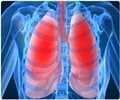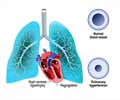
‘Nanoparticles could help predict COPD. In the mucus collected from patients with COPD, the nanoparticles moved slower compared with patients without COPD due to their restrictive nature of mucus.’
Read More..Tweet it Now
A report on the research was published in the European Respiratory Journal.Read More..
According to the World Health Organization, 65 million people have moderate to severe COPD, making it the fifth leading cause of death worldwide. Linked to smoking and pollution, COPD describes a group of incurable, chronic inflammatory, lung-damaging processes marked by coughing, breathlessness and excessive production of spit and mucus.
Currently, the best diagnostic tool for COPD is spirometry, which measures how deeply a person can move air out through their lungs after taking a deep breath.
"Spirometry gives us a good picture of a person’s current lung function, but tells us very little about how their disease will progress," says Neptune, which is why finding a predictive biomarker is so important.
In search of one, the research team focused on mucus, the slimy lubricant secreted by tissues that line airways, intestines and other body passages, forming protective barriers and -- in the lungs -- sweeping away potentially harmful particles inhaled with the air we breathe. Mucus has a structure similar to a water-filled sponge, with many tiny interconnected pores.
Advertisement
"The diffusion of muco-inert particles in airway mucus is primarily hindered by mucus’ structure, and thus the mucus pore size can be estimated based on how fast the particles travel within the mucus samples collected from patients," says Suk.
Advertisement
To test this, the researchers next collected mucus samples from 33 patients who were active or former smokers: Seven of the smokers had no history of COPD, 18 had mild to moderate COPD, and eight had severe COPD as determined by lung function.
The team then added nanoparticles labeled with a fluorescent marker that could be traced by an ultrasensitive camera into the mucus and observed their movement, watching for the speed at which the nanoparticles diffused through the sample.
The researchers found that in mucus collected from patients with COPD, the nanoparticles moved significantly slower compared with patients without COPD, indicating that their mucus had a more restricted structure, which is harder for the nanoparticles to navigate.
The effect was even more pronounced when observing the nanoparticle behavior in mucus samples from patients with severe COPD, indicating that the pore size within the mucus shrinks as COPD progresses.
"If this restricted structure impacts the ability of immune cells to engage infectious pathogens in the lungs, it could potentially serve as a predictor for COPD flares, a critical risk factor in COPD progression," says Neptune.
The researchers state that if future, larger studies validate their findings, the structure of mucus could provide new insight into how COPD progresses, as well as improve therapy.
Source-Eurekalert











